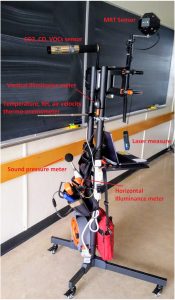
Could how comfortable building occupants find their indoor temperature be predicted by including measurements of carbon dioxide levels in the room? Yes, according to a new paper from UBC’s Building Decisions Research Group. Moreover, researchers found that the more carbon dioxide is present, the less comfortable people are with the temperature.
Before the pandemic, Mechanical Engineering doctoral student Sarah Crosby and UBC SALA’s Assistant Professor Adam Rysanek undertook a field study of 141 office workers at UBC, simultaneously collecting information from individuals through a worker survey and a variety of readings (everything from CO2 and temperature levels, to how much light and sound was present) from a mobile indoor environmental quality (IEQ) measurement station. This information was added to a prior dataset collected by Canada’s National Research Council (NRC) in the early 2000s. The researchers developed a new hierarchical Bayesian logistic regression – a statistical decision-making model for interpreting nuanced observations in data – and applied it to the combined dataset to ensure the results were interpreted accurately. Not only did the they find that the prediction of an occupant’s satisfaction with indoor air temperature can be improved if measurements of CO2 levels are included, but previous observations in this direction had been strengthened with the addition of their new field data as well. The team is making the new data available for public use as part of their paper.
Why is the amount of carbon dioxide in the room related to the occupant’s perception of the temperature? The cause is still unknown, and the authors caution against assuming that there is a causal relationship between them at all. Instead, the correlation may be caused by a third factor such as indoor air quality due to the building design, or the presence of multiple occupants in a room which could increase the amount of CO2 through respiration. More work will be needed to understand why the relationship between CO2 and thermal comfort exists, but the study illustrates the importance of including measurements of non-temperature factors during future thermal comfort studies.
Read “Predicting thermal satisfaction as a function of indoor CO2 levels: Bayesian modelling of new field data” published in Building and Environment at https://doi.org/10.1016/j.buildenv.2021.108569.
